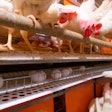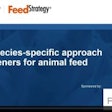In this WATT Poultry Chat, Kyle Vincent, regional sales manager at Central Life Sciences, talks about mastering fly control on poultry operations with Starbar Products.
Elizabeth Doughman, editor, WATT PoultryUSA and Poultry Future: Hello and welcome to WATT Poultry Chat. I'm Elizabeth Doughman, the editor of WATT PoultryUSA and Poultry Future.
Today's chat is brought to you by Central Life Sciences. Central Life Sciences is the maker of Starbar products. Insect control starts with Starbar brands. With products scientifically tailored to insect behavior at pinpoint locations, Starbar products have delivered reliable results that have been trusted for more than 40 years.
Joining us today is Kyle Vincent, regional sales manager at Central Life Sciences. Thanks for joining us, Kyle.
To begin, what flies are commonly found on poultry operations, and what impact did they make?
Kyle Vincent, regional sales manager at Central Life Sciences: Good question. There's always issues with insects in poultry. In layer operations especially, we deal with houseflies quite a bit.
In a world where biosecurity is very important. houseflies are a major issue to be dealt with because they can come and go as they please from poultry facilities. Biosecurity measures are where it starts in determining what comes and goes. When something isn't clean or regulated, that poses a potential problem. So there's a big biosecurity aspect.
Not to mention heavy house fly infestations can reduce feed intake, which reduces productivity and they're a nuisance to employees, frankly. When you've got reduced employee happiness, you got reduced efficiency in the animals and potential biosecurity issues, it's a big problem.
Doughman: What is integrated pest management, also known as IPM? And how can it be applied to poultry operations?
Vincent: Integrated pest management basically means that we like to take a multi pronged approach to fly control. By that, I mean there's not one silver bullet that will fix everything.
We have adulticides that will kill adult flies, we have larvicides that can stop fly development at the larva stage. We've got various different traps that can catch flies when they're either landing or resting, or potentially at a lower level where they're traveling and mating, we use pheromone traps. So lots of different ways that we go after flies because not one thing is going to fix everything right.
Along with all the products that we have from Starbar, there's a lot of education that we do in terms of different management practices with litter, with proper airflow and things that can all impact fly control. It's good to have all the measures in place, so that when you're going after a good IPM, you get a good result, right?
We like to say that we want to plan this IPM program, identify what pests we need to get, then, with that planning, we educate employees on the farm on how we're going to attack this and then we implement the IPM program. So whether that's sprays to knock down adult populations, larvicides to get the larval where they're developing, baits where the flies feed on the baits and die or other traps to capture flies.
We also want to evaluate the IPM program. Because if we don't do that evaluation, we don't know for sure. We might feel better about it that we're doing some things but we want to make sure we're getting results because that's the end goal.
Doughman: What are some recommended products from Starbar that you could use as part of an IPM program for poultry operations?
Vincent: Good question. So with our product line, we have a variety and they're designed to be used at different levels.
Up high flies are landing and resting. So up there, we use sticky traps like the EZ Trap, the Fly Stik and the Stik Junior.
Mid level is where flies are traveling and meeting, so we use odor pheromone traps. These would be the Captivator or the Terminator, the Trap 'N Toss and the fly relief bags. All very similar in the way that they work to attract the flies in. Some are throwaway, some are reusable so based on preference, we can we can tailor it that way.
Down low, flies are going to feed and so that's where we use our baits and that's where we really have a big impact, especially with houseflies in layer operations. We like to use our Quikstrike, Golden Malrin and Durastrike. We put these into your IPM program in such a way that we rotate mid season or every season. At least that way, you use a different class of chemistry and a different active ingredient. You avoid building resistance in that fly population. So that's very important.
I mentioned earlier that we also have larvicide products. A good example of that would be Exhalt. Exhalt is a granular product that we apply directly to fly breeding areas. It's designed to break the fly lifecycle at the larva stage. We've got the adult asides, we've got the larvicide, we've got the traps to capture live flies.
Brand new to our lineup is the Aviator product. Aviator is an aerosol fly bait that is very unique in the way that that can be used. It's a different active ingredient than anything else that's on the market right now. But maybe a little more versatile and where it can be used where maybe your baits aren't going to work quite as well. So we've got a wide variety of products that we can tailor to any specific situation when we're building your IPM program.
Doughman: Thank you so much for sharing these insights. For more information on the solutions discussed here today. Visit central life sciences and www.starbarproducts.com. Thanks again, Kyle, and thanks to you for tuning in.










